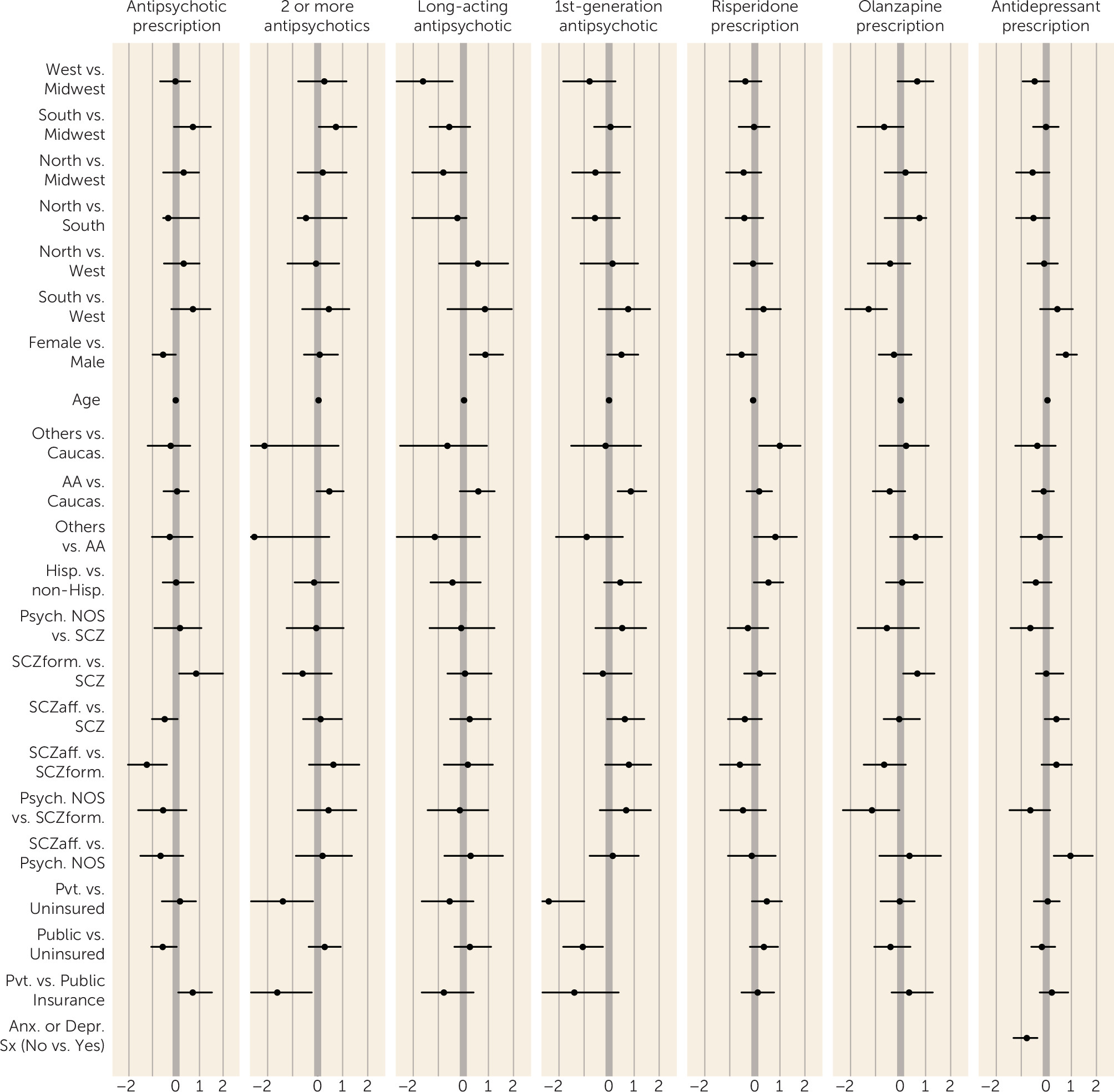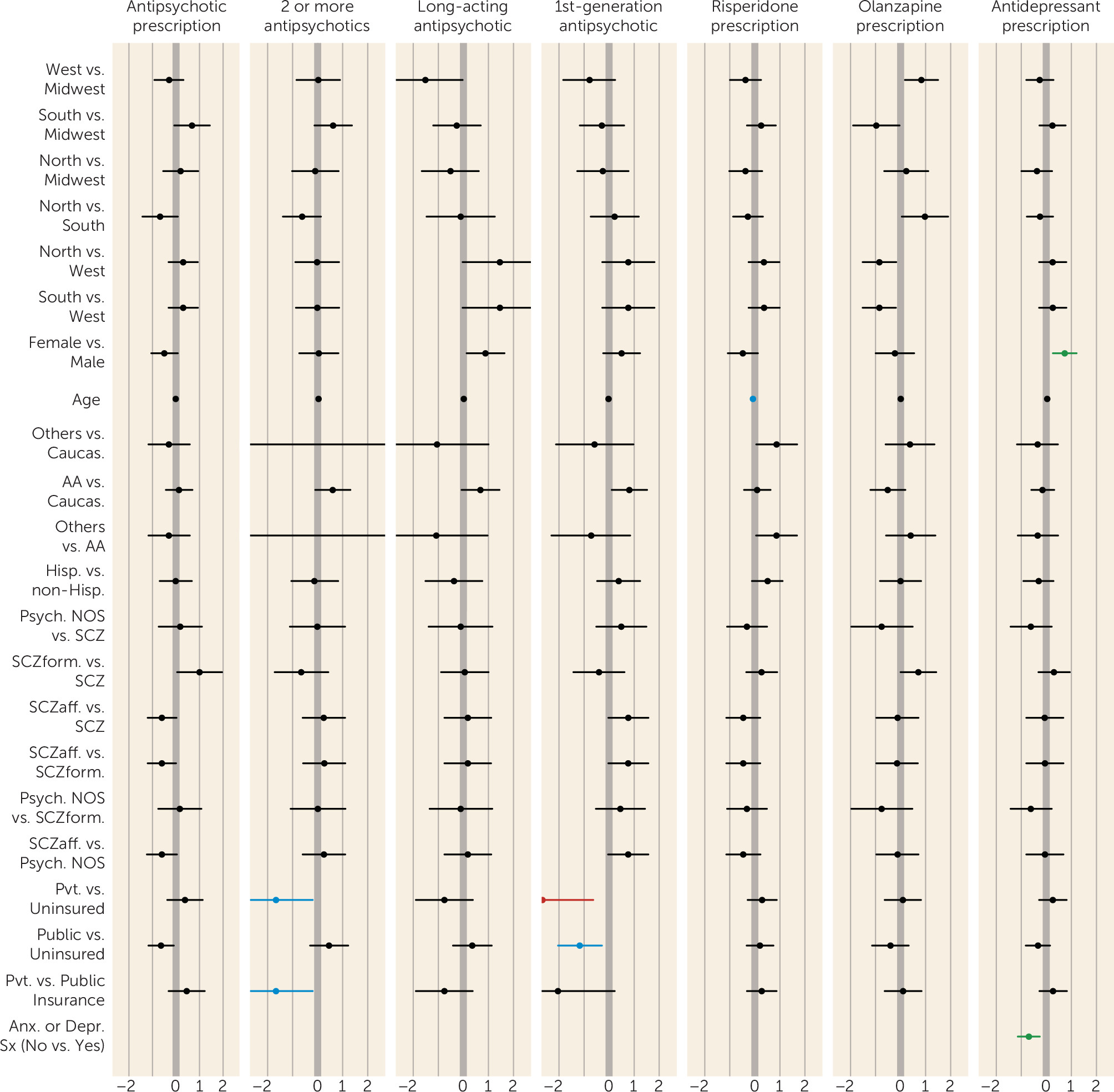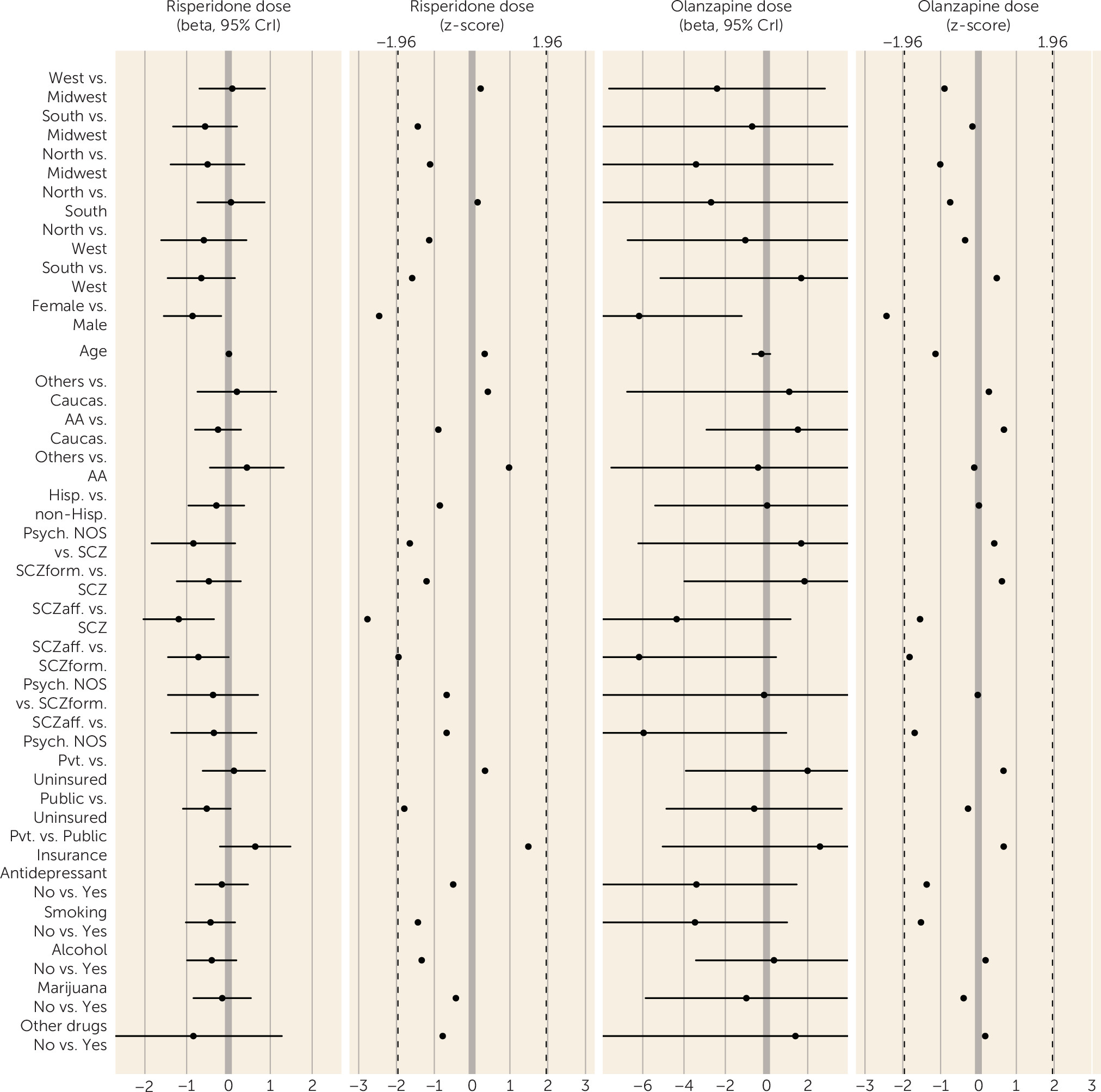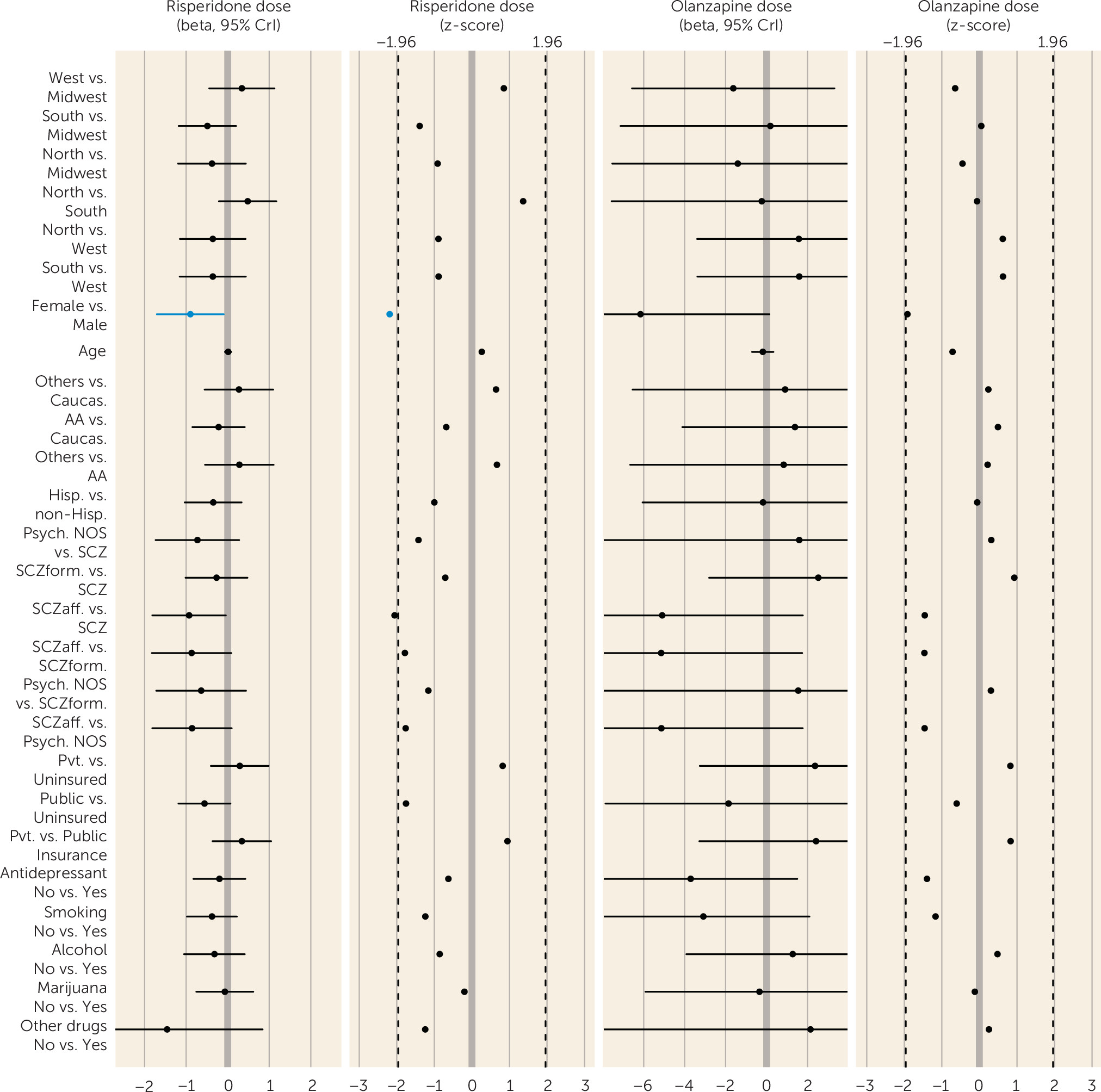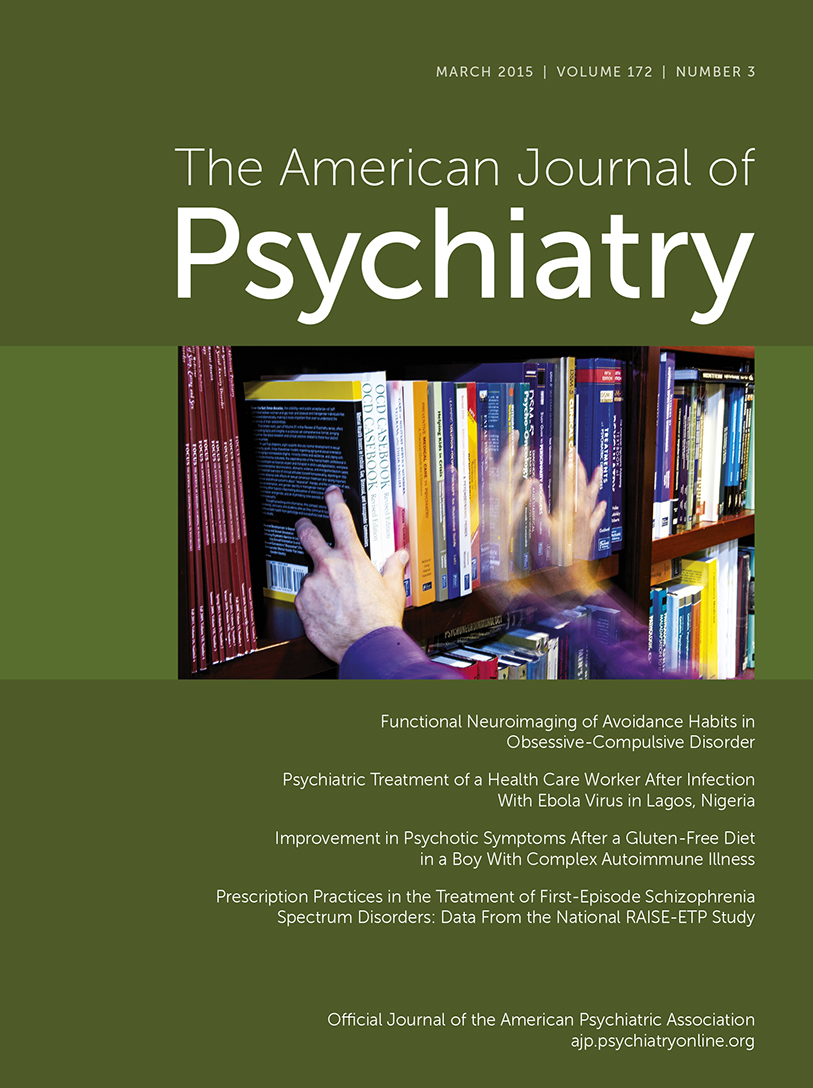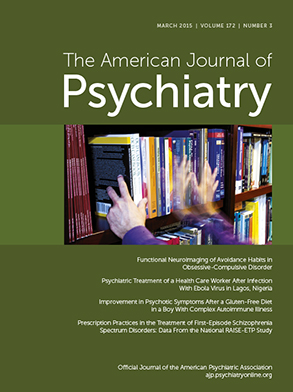The Early Treatment Program (ETP) study, a nationwide comparative effectiveness trial that is part of the National Institute of Mental Health’s Recovery After an Initial Schizophrenia Episode (RAISE) Project (RAISE-ETP), provided the basis for the first national report of U.S. community mental health center medication treatments for the crucial early phase of schizophrenia. In the present study, we addressed two questions: What are the medication treatments currently used in community settings? What factors are associated with choice of medication strategy?
Results
Study Participants
The sample included 404 patients (see the flow diagram in Figure S1 in the
data supplement that accompanies the online edition of this article). Community centers normally do not conduct outreach; new patients arrive through referral from inpatient units, other clinicians, or self-referral. This pattern mostly held for the study; 335 (83%) patients came from these sources, and 88 (17%) from outreach activities (e.g., educating the professional community about RAISE-ETP; educational efforts with potential patients and their families through articles in the local press; information booths at community events). As shown in
Table 1, most patients had a psychiatric hospitalization before study entry. Patients were relatively young on average, with a mean age of 23.6 years. The majority were male, and the sample had diverse racial backgrounds. Approximately half met DSM-IV criteria for schizophrenia; the next most common diagnoses were schizophreniform disorder and schizoaffective disorder. Consistent with early-phase illness, the mean duration of cumulative lifetime antipsychotic treatment was only 46.7 days (SD=45.8).
The frequencies of prescriptions in the major medication classes are listed in
Table 2.
Most patients received prescriptions for antipsychotics, and approximately one-third of patients received prescriptions for antidepressants.
Patients Without Antipsychotic Prescriptions at Study Entry
Fifty-one patients (12.6%) did not have prescriptions for any psychotropic medications at study entry. Sixteen of them (31.4%) had taken antipsychotics in the past, and 24 of them (47.1%) had a past psychiatric inpatient admission. Sixteen patients had prescriptions for psychotropic medications but not antipsychotics; 14 of these had prescriptions for antidepressants, one for clonazepam, and one for clonidine.
Antipsychotic Prescribing Patterns
Of the 337 patients who had prescriptions for an antipsychotic, only 40 (11.9%) received a first-generation agent, including those who received both a first-generation and a second-generation antipsychotic. Long-acting injectable antipsychotics were prescribed for 32 (9.5%) of the patients who received antipsychotics. Of these, 17 had prescriptions for paliperidone palmitate (53.1% of long-acting prescriptions), 11 for haloperidol decanoate (34.4%), three for risperidone microspheres (9.4%), and one for fluphenazine decanoate (3.1%).
Antipsychotic monotherapy was by far the most common pattern. Three hundred (89.0%) of the 337 patients who received prescriptions for antipsychotics had prescriptions for only one antipsychotic (either in single or multiple formulations), while 35 patients (10.4%) had prescriptions for two different antipsychotics and two (0.6%) had prescriptions for three different antipsychotics.
Prescriptions for antipsychotic monotherapy.
As shown in
Table 3, risperidone accounted for about one-third of the 300 prescriptions for antipsychotic monotherapy. The next most commonly prescribed antipsychotic was olanzapine (17.0% of prescriptions), followed by aripiprazole, paliperidone, and quetiapine, each accounting for around 10% of prescriptions.
First-episode schizophrenia treatment guidelines emphasize using low-dosage strategies. As shown in
Table 3, relatively few patients received prescriptions for antipsychotic dosages higher than the suggested 2009 Schizophrenia Patient Outcomes Research Team (PORT) (
4) upper dosing limit for multiepisode patients. High-dosage strategies were found for only certain medications, notably olanzapine; 44.9% of olanzapine prescriptions were for dosages higher than specific PORT guidelines for first-episode treatment, compared with only 7.8% of risperidone prescriptions.
Prescriptions for two or more antipsychotics.
Prescriptions for multiple antipsychotics included combinations of 13 different antipsychotics. The most commonly prescribed agents were risperidone, which was prescribed to 16 (43.2%) of the 37 patients who received multiple agents; quetiapine, prescribed to 13 patients (35.1%); olanzapine, prescribed to 10 patients (27.0%); aripiprazole, prescribed to nine patients (24.3%); and haloperidol, prescribed to eight patients (21.6%).
Medications for motor side effects.
We lack data on perceived indications for prescriptions, but anticholinergic medications and beta-blockers are usually prescribed for motor side effects in patients taking antipsychotics. Seventy-one (21.1%) of the 337 patients who received antipsychotics had concurrent prescriptions for an anticholinergic medication, and seven (2.1%) for a beta-blocker. Antianxiety agents can be prescribed for motor side effects as well as for anxiety, or for both. Thirty-nine (11.6%) of the 337 patients who received prescriptions for antipsychotics also received prescriptions for antianxiety agents.
Antidepressants prescribed with antipsychotics.
A total of 115 patients had prescriptions for both an antidepressant and an antipsychotic. Only 57 (49.6%) of these patients had any SCID interview documentation of lifetime depression (i.e., major depressive disorder, depressive disorder not otherwise specified, or schizoaffective disorder, depressive type) or anxiety (i.e., panic disorder, social phobia, obsessive-compulsive disorder, posttraumatic stress disorder, generalized anxiety disorder, anxiety due to a medical condition, or anxiety disorder not otherwise specified) that might broadly be considered justification for antidepressant treatment. Although not recommended by treatment guidelines, antidepressants are sometimes prescribed for negative symptoms. However, only six (10.3%) of the remaining 58 patients with prescriptions for antidepressants had any prominent negative symptoms according to the SCID interview.
Factors Associated With Prescribing Patterns
These analyses are summarized here and in
Figures 1 and
2 (factors associated with prescription patterns) and
Figures 3 and
4 (factors associated with dosing patterns for oral risperidone or olanzapine), and are presented in detail in Tables S1 and S2 in the online
data supplement.
For antipsychotic prescription in general, univariate but not multivariate analyses (all PPRF values <21.2%; all lacking evidence) suggested that women and patients with public (compared with private) insurance were less likely to receive an antipsychotic, and patients with schizophreniform disorder (compared with schizophrenia or schizoaffective disorder) were more likely to receive an antipsychotic. Prescriptions for two or more antipsychotics were more likely for patients at southern (compared with midwestern) sites in univariate but not multivariate analyses (PPRF=4.6%; lacking evidence). In multivariate analyses, patients with private insurance were less likely to receive prescriptions for more than one antipsychotic than either patients with public insurance (PPRF=52.9%; some evidence) or those with no insurance (PPRF=51.9%; some evidence). Prescription of long-acting injectable antipsychotics was more frequent for women and for patients at midwestern (compared with western) sites in univariate but not multivariate analyses (PPRF values, 40.2% and 20.9%, respectively; both lacking evidence).
In multivariate analyses, prescription of first-generation antipsychotics was more common for uninsured patients (compared with those with private insurance [PPRF=96.2%; strong evidence] or public insurance [PPRF=56.4%; some evidence]). African Americans were more likely than Caucasians to receive prescriptions for first-generation antipsychotics in univariate but not multivariate analyses (PPRF=23.1%; lacking evidence).
For second-generation antipsychotics, multivariate analyses revealed that younger patients (PPRF=66.4%; some evidence) were more likely to receive prescriptions for risperidone, and univariate analyses showed that Hispanics (PPRF=17.5%; lacking evidence) and other racial groups (PPRF=17.5%; lacking evidence) (compared with Caucasians) were more likely to receive prescriptions for risperidone. Women received lower risperidone dosages than men (PPRF=52.2%; some evidence). Univariate but not multivariate analyses (all PPRF values <17%; all lacking evidence) showed that patients with psychosis not otherwise specified or schizoaffective disorder (compared with those with schizophrenia) as well as those with public insurance (compared with those with no insurance) received lower dosages of risperidone. Olanzapine prescription in univariate but not multivariate analyses (all PPRF values <24%; all lacking evidence) was more likely among patients at western (compared with southern) sites and among those with schizophreniform disorder (compared with psychosis not otherwise specified or schizophrenia). The mean olanzapine dosage was lower for women than men and for those with schizoaffective disorder (compared with psychosis not otherwise specified) in univariate but not multivariate analyses (PPRF values, 47.7% and 9.7%, respectively; all lacking evidence).
Antidepressant prescription was more likely among women (PPRF=83.5%; positive evidence) and among patients with depression or anxiety symptoms (PPRF=87.1%; positive evidence); older patients and those with schizoaffective disorder (compared with psychosis not otherwise specified) were more likely to receive antidepressants in univariate analyses only (PPRF=23.8% and 1.6%, respectively; all lacking evidence).
Patients Who Might Benefit From Prescription Modifications
Analyses of which patients might benefit from prescription modifications excluded those who had not received prescriptions for psychotropic medications at baseline, as some of these patients would not be expected to have prescriptions (e.g., those who were initiating psychiatric treatment at study entry). A total of 159 patients (39.4% of the sample) met criteria for potential benefit. Of these, 14 (8.8%) had prescriptions for recommended antipsychotics at higher-than-recommended dosages, 51 (32.1%) had prescriptions for olanzapine (often at high dosages), 37 (23.3%) had prescriptions for more than one antipsychotic, 58 (36.5%) had prescriptions for an antipsychotic but also an antidepressant without a clear indication, 16 (10.1%) had prescriptions for psychotropic medications without an antipsychotic, and five (1.2%) had prescriptions for stimulants.
Discussion
To our knowledge, this is the first report of psychotropic medication prescription patterns for people with first-episode schizophrenia spectrum disorders in U.S. community mental health settings. A Finnish national discharge registry study by Tiihonen et al. (
22) provides an international comparison. Prescription rates for long-acting injectables and for multiple antipsychotics were similar in the two studies, and risperidone was the most commonly used oral antipsychotic in both countries, followed by olanzapine. Clozapine use was much higher in Finland. This may reflect different treatment practices, or it may be that more of the Finnish patients failed to respond to other antipsychotics during outpatient treatment before cohort identification based on their first hospitalization.
Practice guidelines with specific first-episode recommendations and first-episode research data (
2–
6) support 1) the need for antipsychotic treatment, 2) the use of low antipsychotic dosing, and 3) the need to minimize side effects, especially metabolic ones, during early-phase treatment. Did community clinicians follow these core principles? The need for antipsychotic treatment was widely recognized. Only 16 patients did not receive prescriptions for antipsychotics who clearly had been evaluated for psychiatric problems, as evidenced by the prescription of a psychotropic agent. Another 35 patients did not receive prescriptions for any psychotropic agents; how many of these patients had recently seen a prescribing clinician who did not recognize a need for psychotropic agents is unknown.
Antipsychotic prescriptions were mostly concordant with recommendations. An exception was the relatively common use of olanzapine (17% of antipsychotic prescriptions). Given olanzapine’s more frequent adverse metabolic side effects (
23), especially with first-episode patients (
24), PORT guidelines recommend that this agent not be used for first-episode treatment. Strikingly, olanzapine was much more frequently prescribed at higher-than-recommended dosages than other antipsychotics. We considered the possibility that this agent was prescribed for patients who had not improved with other antipsychotics, but the data do not support this. The mean duration of antipsychotic treatment for patients with olanzapine prescriptions (56.2 days [95% CI=45.7, 66.7]) was similar to that for other antipsychotics (e.g., 57.8 days [95% CI=44.3, 71.3] for paliperidone). The minimizing of side effects requires optimizing all medications, not just antipsychotics. Of note, antidepressants were prescribed for about one-third of patients, but only about half of these patients had clear symptom indications for antidepressants.
Our univariate analyses identified specific factors associated with particular prescription practices. Prescription may be influenced by several factors. People designing practice improvement efforts may wish to focus on factors identified by the multivariate analyses, given that these are less biased when confounding factors are present. Both analysis types are informative in different contexts, and we include both in our discussion.
Among demographic variables, we found that women in our sample received lower antipsychotic dosages, as has been reported for multiepisode patients (
10). Women were also more likely to receive prescriptions for long-acting injectable antipsychotics (univariate analyses only) and, even controlling for depressive and anxiety symptoms, for antidepressants. In multiepisode studies, African Americans have been found to be more likely to receive prescriptions for first-generation antipsychotics (
12,
13), and Hispanics to receive prescriptions for risperidone (
25); our univariate results suggest that these patterns may also apply to first-episode patients. Younger patients were more likely to receive prescriptions for risperidone, possibly because of this agent's U.S. Food and Drug Administration indication for adolescent treatment.
Among variables related to service delivery, we found some univariate regional differences in prescription practices; the regions that differed varied across prescription practices, with no region consistently having different practices from the other regions. Insurance status effects were highly consistent. Private insurance was associated with better medication prescription: a higher likelihood of receiving a prescription for an antipsychotic and a lower likelihood of receiving two or more antipsychotics or receiving a first-generation antipsychotic—a medication choice discouraged by some (
3) but not all (
4) first-episode guidelines.
Diagnosis had no effect on prescription of more than one antipsychotic or prescription of long-acting injectables, first-generation antipsychotics, or risperidone. The univariate association between schizoaffective diagnoses and antidepressant prescription is consistent with the mood symptoms required for the diagnosis; the basis for the univariate association between schizophreniform disorder and olanzapine prescription is unclear. Diagnostic associations were not consistent across analyses of risperidone and olanzapine dosing. Finally, smoking and substance use were not associated with risperidone or olanzapine dosing.
Our data have limitations. Our sample may not be as generalizable as a true epidemiological sample, despite its recruitment from 34 sites in 21 states. Second, most patients’ prescriptions were made at another facility, usually an inpatient unit, prior to referral to our study community centers. Thus, we lack data on the prescribing clinicians’ decision processes, their perceived indications for prescriptions, and the effects of patient preferences. Third, the mean total lifetime duration of antipsychotic prescription in our sample was only 46.7 days. For most patients, past treatment response should not have substantially influenced medication selection, but some patients may have had enough treatment to document unusual responses to medication, which could have led to some treatments’ not conforming to guidelines. Fourth, although our sample was relatively large, our study also had a large number of sites, which prevented us from including individual sites in our analyses. Grouping sites into geographic regions provided a means to examine the uniformity of prescribing patterns nationally, but it cannot provide data on individual site practices.
Despite these limitations, our data have health policy implications. The marked use of second-generation over first-generation antipsychotics in our study may be warranted by evidence of better efficacy (
26) and relapse prevention (
27) and fewer motor side effects (
26) with second-generation antipsychotics with early-phase patients. However, the marked metabolic effects of some second-generation antipsychotics in early-phase patients (
28–
32) suggests that efforts to increase adherence to recommended physical health monitoring of first-episode patients (e.g.,
33) should be strongly encouraged.
Although each questionable medication practice we identified affected only 1.2% to 14.4% of patients, cumulatively 39.4% of patients might have benefited from changes in their psychotropic medication prescriptions. Primary immediate targets for improving first-episode community treatment include discouraging the use of two or more antipsychotics and the prescription of olanzapine, especially at high dosages. Aside from educational efforts for prescribing clinicians, changes in reimbursement models or care delivery may need to be considered to facilitate evidence-based treatment during the crucial early phase of schizophrenia. Patients with private insurance had strikingly lower rates of prescription of two or more antipsychotics than patients with public insurance or no insurance.
A large number of our patients received antidepressants without clear indications for their use. Either prescribers responded to symptoms not detected by our research interviews or they interpreted schizophrenia symptoms as mood or anxiety symptoms. If the latter is true, training to improve clinicians’ ability to diagnose schizophrenia spectrum disorders as distinct from mood or anxiety disorders is warranted, especially for female patients, given our finding that women were more likely to receive prescriptions for antidepressants independent of symptom indications.
Better medication treatment of the initial illness episode raises the possibility of better acute and long-term outcomes. An important first-episode research question is whether promoting more evidence-based care does indeed improve outcomes and, if it does, what level of adherence to evidence-based practice is required.
Acknowledgments
The authors thank the participating patients and their families and acknowledge the contributions of the staff at the study’s 34 sites: Burrell Behavioral Health (Columbia), Burrell Behavioral Health (Springfield), Catholic Social Services of Washtenaw County, Center for Rural and Community Behavior Health New Mexico, Cherry Street Health Services, Clinton-Eaton-Ingham Community Mental Health Authority, Cobb County Community Services Board, Community Alternatives, Community Mental Health Center of Lancaster County, Community Mental Health Center, Inc., Eyerly Ball Iowa, Grady Health Systems, Henderson Mental Health Center, Howard Center, Human Development Center, Lehigh Valley Hospital, Life Management Center of Northwest Florida, Mental Health Center of Denver, Mental Health Center of Greater Manchester, Nashua Mental Health, North Point Health and Wellness, Park Center, PeaceHealth Oregon/Lane County Behavioral Health Services, Pine Belt Mental Health Center, River Parish Mental Health Center, Providence Center, San Fernando Mental Health Center, Santa Clarita Mental Health Center, South Shore Mental Health Center, St. Clare’s Hospital, Staten Island University Hospital, Terrebonne Mental Health Center, United Services, and University of Missouri-Kansas City School of Pharmacy.
